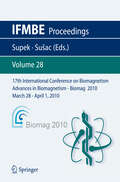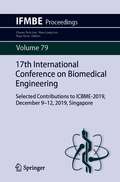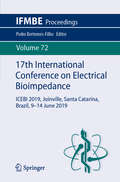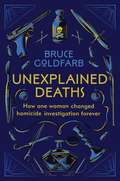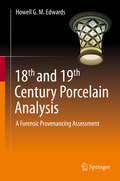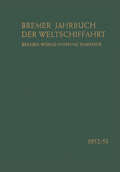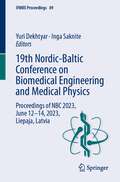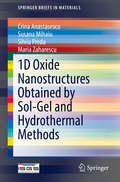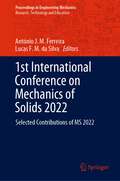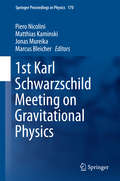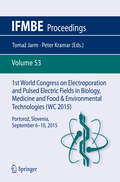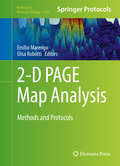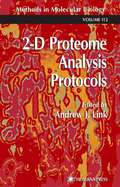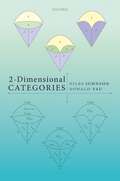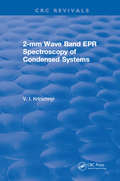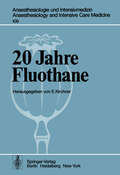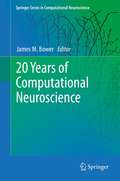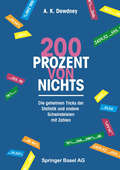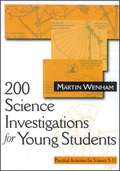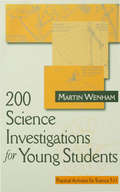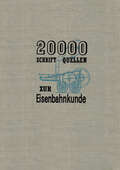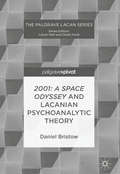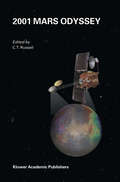- Table View
- List View
17th International Conference on Biomagnetism Advances in Biomagnetism - Biomag 2010 - March 28 - April 1, 2010: Biomag March 28 - April 1, 2010 (IFMBE Proceedings #28)
by Selma Supek Ana Susac40th anniversary of "medical uses of SQUID" th It is my great pleasure and honor to invite you to the 17 International Conference on Biomagnetism – Biomag2010 held in Dubrovnik, Croatia from Sunday, March 28 through Thursday, April 1, 2010. The interdisciplinary field of biomagnetism includes dynamic and evolving SQUID-based technologies offering advanced real-time methods for noninvasive assessments of magnetic signals from the brain, heart and other organs as well as a range of modeling, mathematical and computational methods for functional source localization approaches. Excellent spatial resolution and unique, millisecond, temporal resolution of biomagnetic techniques allow insights into cortical neurodynamics and neurobiological basis of the human brain as well as assessment of heart and other organs functions in health and disease. Biomag2010 will be a great opportunity for an exchange of ideas and presentation of the latest developments in instrumentation, modeling approaches, basic and clinical biomedical studies. We are particularly proud to announce the celebration of the 40th anniversary of the first SQUID-based MCG measurements published on April 1, 1970. Since then ''medical uses of SQUID'' were dynamic and growing, including the most recent developments, in combination with a low field MRI, toward a ''direct neuronal imaging''. Dubrovnik, the host city of the Biomag2010, a jewel on the Adriatic, will be a superb and stimulating setting for both scientific and social aspects of this meeting. I am looking forward to hosting you in Dubrovnik, Croatia in spring of 2010.
17th International Conference on Biomedical Engineering: Selected Contributions to ICBME-2019, December 9–12, 2019, Singapore (IFMBE Proceedings #79)
by Chwee Teck Lim Hwa Liang Leo Raye YeowThis book gathers contributions presented at the 17th International Conference on Biomedical Engineering, held on December 9-12, 2019, in Singapore. It continues the tradition of the previous conference proceedings, thus reporting on both fundamental and applied research. It includes a set of carefully selected chapters reporting on new models and algorithms and their applications in medical diagnosis or therapy. It also discusses advances in tele-health and assistive technologies, as well as applications of nanotechnologies. Organized jointly by the Department of Biomedical Engineering of the National University of Singapore and the Biomedical Engineering Society (Singapore), this book offers a timely snapshot of innovative research and technologies and a source of inspiration for future developments and collaborations in the field of biomedical engineering.
17th International Conference on Electrical Bioimpedance: ICEBI 2019, Joinville, Santa Catarina, Brazil, 9-14 June 2019 (IFMBE Proceedings #72)
by Pedro Bertemes-FilhoThis book gathers the proceedings of the 17th International Conference on Electrical Bioimpedance (ICEBI 2019), held on June 9-14, in Joinville, Santa Catarina, Brazil. The chapters cover the latest knowledge and developments concerning: sensors and instrumentation to measure bioimpendance, bioimpedance imaging techniques, theory and modeling and bioimpendance, as well as cutting-edge clinical applications of bioimpendance. All in all, this book provides graduate students and researchers with an extensive and timely snapshot of current research and challenges in the field of electrical bioimpendance, and a source of inspiration for future research and cross-disciplinary collaborations.
18 Tiny Deaths: The Untold Story of Frances Glessner Lee and the Invention of Modern Forensics
by Bruce GoldfarbFor most of human history, sudden and unexpected deaths of a suspicious nature, when they were investigated at all, were examined by lay persons without any formal training. People often got away with murder. Modern forensic investigation originates with Frances Glessner Lee - a pivotal figure in police science.Frances Glessner Lee (1878-1962), born a socialite to a wealthy and influential Chicago family, was never meant to have a career, let alone one steeped in death and depravity. Yet she became the mother of modern forensics and was instrumental in elevating homicide investigation to a scientific discipline. Frances Glessner Lee learned forensic science under the tutelage of pioneering medical examiner Magrath - he told her about his cases, gave her access to the autopsy room to observe post-mortems and taught her about poisons and patterns of injury. A voracious reader too, Lee acquired and read books on criminology and forensic science - eventually establishing the largest library of legal medicine. Lee went on to create The Nutshell Studies of Unexplained Death - a series of dollhouse-sized crime scene dioramas depicting the facts of actual cases in exquisitely detailed miniature - and perhaps the thing she is most famous for. Celebrated by artists, miniaturists and scientists, the Nutshell Studies are a singularly unusual collection. They were first used as a teaching tool in homicide seminars at Harvard Medical School in the 1930s, and then in 1945 the homicide seminar for police detectives that is the longest-running and still the highest-regarded training of its kind in America. Both of which were established by the pioneering Lee.In 18 Tiny Deaths, Bruce Goldfarb weaves Lee's remarkable story with the advances in forensics made in her lifetime to tell the tale of the birth of modern forensics.
18th and 19th Century Porcelain Analysis: A Forensic Provenancing Assessment
by Howell G. EdwardsThis book addresses the contributions made by analytical chemistry to the characterisation of 18th and early 19th Century English and Welsh porcelains commencing with the earliest reports of Sir Arthur Church and of Herbert Eccles and Bernard Rackham using chemical digestion techniques and concluding with the most recent instrumental experiments, which together span more than a hundred years of study. From the earliest experiments which required necessarily the sacrifice of significant portions of each specimen, which may already have been damaged , to the latest experiments which needed only microsampling or the non-destructive interrogation of valuable perfect specimens a comprehensive survey is undertaken of more than twenty manufactories of quality porcelains. The correlation is made between the quantitative elemental oxide determinations of the scanning electron microscopic diffraction and Xray fluorescence data and the qualitative molecular spectroscopic Raman data to demonstrate their complementarity and use in the holistic forensic assessment of the origin of the fired procelains ; this will form the groundwork for the adoption of analytical techniques for the attribution of unknown or questionable procelains to their potential source factories . The book will also examine the perception of what constitutes a porcelain and its definitions and examines the assignment of porcelains to types which currently employs the definitions of hard paste , soft paste , hybrid , magnesian and bone china from the conclusions derived from the analytical data and a consideration of the raw materials employed in their manufacturing processes. During the discussion of this analytical evidence several themes and protocols have been established for its utilisation in the potential identification of porcelains and several case studies undertaken for this purpose are cited. The book will be of interest to analytical scientists , to museum ceramics curators and to ceramics historians.
1952/53: Analyse der Schiffahrtswirtschaft (Bremer Jahrbuch Weltschiffahrt Bremen World Shipping Yearbook)
by Gustav A. Theel19th Nordic-Baltic Conference on Biomedical Engineering and Medical Physics: Proceedings of NBC 2023, June 12–14, 2023, Liepaja, Latvia (IFMBE Proceedings #89)
by Yuri Dekhtyar Inga SakniteThis book reports on new trends, challenges and solutions, in the multidisciplinary fields of biomedical engineering and medical physics. Contributions spans from biomechanics, to robotic rehabilitation, radiation oncology, and image and signal processing, among many other topics. They cover advanced devices for diagnosis or patient monitoring, as well as for therapy (non-invasive surgery, rehabilitation and more). Gathering the proceedings of the 19th Nordic-Baltic Conference on Biomedical Engineering and Medical Physics, NBC 2023, held on June 12–14, 2023, in Liepaja, Latvia, this book is expected to inform a wide audience of researchers, engineers and other professionals working in the broad field of biomedical engineering, and to offer a timely snapshot of research and projects that have been carried out within Nordic and Baltic countries, in particular, but not limited to them.
1D Oxide Nanostructures Obtained by Sol-Gel and Hydrothermal Methods (SpringerBriefs in Materials)
by Crina Anastasescu Susana Mihaiu Silviu Preda Maria ZaharescuThis book presents wet chemical sol-gel and hydrothermal methods for 1D oxide nanostructure preparation. These methods represent an attractive route to multifunctional nanomaterials synthesis, as they are versatile, inexpensive and, thus, appropriate for obtaining a wide range of oxide materials with tailored morphology and properties. Three specific oxides (SiO2, TiO2, ZnO) are discussed in detail in order to illustrate the principle of the sol-gel and hydrothermal preparation of 1D oxide nanostructures. Other oxides synthesized via this method are also briefly presented. Throughout the book, the correlation between the tubular structure and the physico-chemical properties of these materials is highlighted. 1D oxide nanostructures exhibit interesting optical and electrical properties, due to their confined morphology. In addition, a well-defined geometry can be associated with chemically active species. For example, the pure SiO2 nanotubes presented a slight photocatalytic activity, while the Pt-doped SiO2 tubular materials act as microreactors in catalytic reactions. In the case of titania and titanate nanotubes, large specific surface area and pore volume, ion-exchange ability, enhanced light absorption, and fast electron-transport capability have attracted significant research interest. The chemical and physical modifications (microwave assisted hydrothermal methods) discussed here improve the formation kinetics of the nanotubes. The ZnO nanorods/tubes were prepared as random particles or as large areas of small, oriented 1D ZnO nanostructures on a variety of substrates. In the latter case a sol-gel layer is deposited on the substrate prior to the hydrothermal preparation. Using appropriate dopants, coatings of ZnO nanorods with controlled electrical behavior can be obtained.
1st International Conference on Mechanics of Solids 2022: Selected Contributions of MS 2022 (Proceedings in Engineering Mechanics)
by António J. M. Ferreira Lucas F. M. da SilvaThis book provides selected papers presented at the 1st International Conference on Mechanics of Solids, held in Porto, Portugal, November 3-4, 2022.The book focuses on the mechanics of deformable solids, dynamics of particles and rigid bodies. Topics like mechanical behaviour of materials, mechanics of composite materials, plasticity, fracture mechanics, and optimum design methods are covered. This volume provides the latest trends related to mechanics of solids and appeals to researchers and practitioners across the broad spectrum.
1st Karl Schwarzschild Meeting on Gravitational Physics (Springer Proceedings in Physics #170)
by Piero Nicolini Matthias Kaminski Jonas Mureika Marcus BleicherThese proceedings collect the selected contributions of participants of the First Karl Schwarzschild Meeting on Gravitational Physics, held in Frankfurt, Germany to celebrate the 140th anniversary of Schwarzschild's birth. They are grouped into 4 main themes: I. The Life and Work of Karl Schwarzschild; II. Black Holes in Classical General Relativity, Numerical Relativity, Astrophysics, Cosmology, and Alternative Theories of Gravity; III. Black Holes in Quantum Gravity and String Theory; IV. Other Topics in Contemporary Gravitation.Inspired by the foundational principle ``By acknowledging the past, we open a route to the future", the week-long meeting, envisioned as a forum for exchange between scientists from all locations and levels of education, drew participants from 15 countries across 4 continents. In addition to plenary talks from leading researchers, a special focus on young talent was provided, a feature underlined by the Springer Prize for the best student and junior presentations.
1st World Congress on Electroporation and Pulsed Electric Fields in Biology, Medicine and Food & Environmental Technologies: Portorož, Slovenia, September 6 –10, 2015 (IFMBE Proceedings #53)
by Tomaz Jarm Peter KramarThis volume presents the proceedings of the 1st World Congress on Electroporation and Pulsed Electric Fields in Biology, Medicine and Food & Environmental Technologies (WC2015). The congress took place in Portorož, Slovenia, during the week of September 6th to 10th, 2015. The scientific part of the Congress covered different aspects of electroporation and related technologies and included the following main topics: · Application of pulsed electric fields technology in food: challenges and opportunities· Electrical impedance measurement for assessment of electroporation yield· Electrochemistry and electroporation· Electroporation meets electrostimulation· Electrotechnologies for food and biomass treatment· Food and biotechnology applications· In vitro electroporation - basic mechanisms· Interfacial behaviour of lipid-assemblies, membranes and cells in electric fields· Irreversible electroporation in clinical use· Medical applications: electrochemotherapy· Medical applications: gene therapy· Non-electric field-based physical methods inducing cell poration and enhanced molecule transfer· Non-thermal plasmas for food safety, environmental applications and medical treatments· PEF for the food industry: fundamentals and applications· PEF process integration - complex process chains and process combinations in the food industry· Predictable animal models· Pulsed electric fields and electroporation technologies in bioeconomy· Veterinary medical applications
2-D PAGE Map Analysis: Methods and Protocols (Methods in Molecular Biology #1384)
by Emilio Marengo and Elisa RobottiExploring the 2-D gel mapping field, the chapters in this book are separated into four different categories: Part I talks about 2-D maps reproducibility and maps modeling; Part II describes the image analysis tools that provide spot volume datasets; Part III is about the statistical methods applied to spot volume datasets to identify candidate biomarkers; and Part IV discusses differential analysis from direct image analysis tools. 2-D PAGE Map Analysis: Methods and Protocols provides a unique approach to 2-D gel mapping, in that it helps users avoid drawbacks due to ignorance of the basic theoretical mechanisms underlying the technique, including data handling and proper tools for spot analysis. Written in the highly successful Methods in Molecular Biology series format, chapters include introductions to their respective topics, lists of the necessary materials, step-by-step, readily reproducible laboratory protocols, and tips on troubleshooting and avoiding known pitfalls.Cutting-edge and thorough, 2-D PAGE Map Analysis: Methods and Protocols, is a useful resource for any scientist or researcher, with a mathematical background, who is interested in 2-D gel mapping.
2-D Proteome Analysis Protocols (Methods in Molecular Biology #112)
by Andrew J. LinkWith the completion of sequencing projects and the advancement of a- lytical tools for protein identification, proteomics—the study of the expressed part of the genome—has become a major region of the burgeoning field of functional genomics. High-resolution 2-D gels can reveal virtually all p- teins present in a cell or tissue at any given time, including posttranslationally modified proteins. Changes in the expression and structure of most cellular proteins caused by differentiation or external stimuli can be displayed and eventually identified using 2-D protein gels. 2-D Proteome Analysis Protocols covers all aspects of the use of 2-D protein electrophoresis for the analysis of biological problems. The contri- tors include many of the leaders in the fields of biochemistry and analytical chemistry who were instrumental in the development of high-resolution 2-D gels, immobilized pH gradients, computer analysis, and mass spectromet- based protein identification methodologies. This book is intended as a benchtop manual and guide both for novices to 2-D gels and for those aficionados who wish to try the newer techniques. Any group using protein biochemistry—especially in the fields of molecular biology, biochemistry, microbiology, and cell biology—should find this book eminently useful. 2-D Proteome Analysis Protocols takes the researcher through the c- plete process of working with 2-D protein gels from making the protein - tract to finally identifying the proteins of interest. It includes protocols for generating 2-D protein extracts from most of the standard model organisms, including bacteria, yeast, nematode, Drosophila, plants, mouse, and human.
2-Dimensional Categories
by Niles Johnson Donald YauCategory theory emerged in the 1940s in the work of Samuel Eilenberg and Saunders Mac Lane. It describes relationships between mathematical structures. Outside of pure mathematics, category theory is an important tool in physics, computer science, linguistics, and a quickly-growing list of other sciences. This book is about 2-dimensional categories, which add an extra dimension of richness and complexity to category theory. 2-Dimensional Categories is an introduction to 2-categories and bicategories, assuming only the most elementary aspects of category theory. A review of basic category theory is followed by a systematic discussion of 2-/bicategories, pasting diagrams, lax functors, 2-/bilimits, the Duskin nerve, 2-nerve, internal adjunctions, monads in bicategories, 2-monads, biequivalences, the Bicategorical Yoneda Lemma, and the Coherence Theorem for bicategories. Grothendieck fibrations and the Grothendieck construction are discussed next, followed by tricategories, monoidal bicategories, the Gray tensor product, and double categories. Completely detailed proofs of several fundamental but hard-to-find results are presented for the first time. With exercises and plenty of motivation and explanation, this book is useful for both beginners and experts.
2-mm Wave Band EPR Spectroscopy of Condensed Systems
by V. I. KrinichnyiThis is the first book to summarize the problems of using modern high-resolution 2-mm wave band EPR spectroscopy in an interdisciplinary field for the investigation of various condensed systems. The material is well illustrated and the applications are as diverse as possible. The main subjects included are: unique characteristics of 2-mm EPR spectroscopy and appropriate experimental techniques, dynamics and polarity of radical microenvironment in model and biological systems, and the nature of charge carriers and charge transfer mechanisms in organic polymer semiconductors.
2-mm Wave Band EPR Spectroscopy of Condensed Systems
by V. I. KrinichnyiThis is the first book to summarize the problems of using modern high-resolution 2-mm wave band EPR spectroscopy in an interdisciplinary field for the investigation of various condensed systems. The material is well illustrated and the applications are as diverse as possible. The main subjects included are: unique characteristics of 2-mm EPR spectroscopy and appropriate experimental techniques, dynamics and polarity of radical microenvironment in model and biological systems, and the nature of charge carriers and charge transfer mechanisms in organic polymer semiconductors.
20 Jahre Fluothane (Anaesthesiologie und Intensivmedizin Anaesthesiology and Intensive Care Medicine #109)
by E. Kirchner20 Years of Computational Neuroscience (Springer Series in Computational Neuroscience #9)
by James M BowerWhen funding agencies and policy organizations consider the role of modeling and simulation in modern biology, the question is often posed, what has been accomplished ? This book will be organized around a symposium on the 20 year history of the CNS meetings, to be held as part of CNS 2010 in San Antonio Texas in July 2010. The book, like the symposium is intended to summarize progress made in Computational Neuroscience over the last 20 years while also considering current challenges in the field. As described in the table of contents, the chapter’s authors have been selected to provide wide coverage of the applications of computational techniques to a broad range of questions and model systems in neuroscience. The proposed book will include several features that establish the history of the field. For each article, its author will select an article originally appearing in a CNS conference proceedings from 15 – 20 years ago. These short (less than 6 page) articles will provide illustrations of the state of the field 20 years ago. The new articles will describe what has been learned about the subject in the following 20 years, and pose specific challenges for the next 20 years. The second historical mechanism will be the reproduction of the first 12 years of posters from the CNS meeting. These posters in and of themselves have become famous in the field (they hang in the halls of the NIH in Bethesda Maryland) and were constructed as allegories for the state and development of computational neuroscience. The posters were designed by the book’s editor, who will, for the first time, provide a written description of each poster.
200 Prozent von nichts: Die geheimen Tricks der Statistik und andere Schwindeleien mit Zahlen
by A.K. Dewdney200 Science Investigations for Young Students: Practical Activities for Science 5 to 11 (1st edition) (PDF)
by Martin WenhamThis book enables teachers to develop a complete range of basic investigations for science with students aged five to 11 year years. It demonstrates how children can use hands-on activities to consolidate and extend their knowledge and understanding. Investigations are presented in a generic form, so that teachers can work through them and adapt them to meet the particular needs of their own classes. The presentation of activities ranges from highly-structured sequences of instructions and questions (with answers!), to more general discussions, depending on the approach needed and the likely variations in equipment and materials available. The content has been guided by, but not limited to, The National Curriculum 2000 and the Initial Teacher Training Curriculum for Primary Science, issued by the Teacher Training Agency.
200 Science Investigations for Young Students
by Martin WenhamThis book enables teachers to develop a complete range of basic investigations for science with students aged five to 11 years. It demonstrates how children can use hands-on activities to consolidate and extend their knowledge and understanding. Investigations are presented in a generic form, so that teachers can work through them and adapt them to meet the particular needs of their own classes. The presentation of activities ranges from highly-structured sequences of instructions and questions (with answers!), to more general discussions, depending on the approach needed and the likely variations in equipment and materials available. Each activity is aimed to help any teacher carry out significant scientific investigations with their class, and where necessary, to learn alongside them. - Almost every investigation and activity has been tested by the author. - Investigations use readily-available, non-specialist or recycled materials. The context of this book is children's need to learn through first-hand experience of the world around them. This book is an essential resource for teachers planning an effective science programme, or for student teachers needing to broaden their scientific knowledge and understanding. 200 Science Investigations for Young Students is the companion volume of activities which demonstrate the theories in Martin Wenham's Understanding Primary Science. The content has been guided by, but not limited to, The National Curriculum 2000 and the Initial Teacher Training Curriculum for Primary Science, issued by the Teacher Training Agency.
20000 Schriftquellen zur Eisenbahnkunde
by Kurt Ewald Henschel und Sohn G.m.b.HDieser Buchtitel ist Teil des Digitalisierungsprojekts Springer Book Archives mit Publikationen, die seit den Anfängen des Verlags von 1842 erschienen sind. Der Verlag stellt mit diesem Archiv Quellen für die historische wie auch die disziplingeschichtliche Forschung zur Verfügung, die jeweils im historischen Kontext betrachtet werden müssen. Dieser Titel erschien in der Zeit vor 1945 und wird daher in seiner zeittypischen politisch-ideologischen Ausrichtung vom Verlag nicht beworben.
2001: A Space Odyssey and Lacanian Psychoanalytic Theory
by Daniel BristowIn 1968, Stanley Kubrick completed and released his magnum opus motion picture 2001: A Space Odyssey; a time that was also tremendously important in the formation of the psychoanalytic theory of Jacques Lacan. Bringing these figures together, Bristow offers a study that goes beyond, as the film did. He extends Lacan’s late topological insights, delves into conceptualisations of desire, in G. W. F. Hegel, Alexandre Kojève, and Lacan himself, and deals with the major themes of cuts (filmic and psychoanalytic); space; silence; surreality; and ‘das Ding’, in relation to the movie’s enigmatic monolith. This book is a tour de force of psychoanalytic theory and space odyssey that will appeal to academics and practitioners of psychoanalysis and film studies, as well as to any fan of Kubrick’s work.
2001: A Space Odyssey and Lacanian Psychoanalytic Theory
by Daniel BristowIn 1968, Stanley Kubrick completed and released his magnum opus motion picture 2001: A Space Odyssey; a time that was also tremendously important in the formation of the psychoanalytic theory of Jacques Lacan. Bringing these figures together, Bristow offers a study that goes beyond, as the film did. He extends Lacan’s late topological insights, delves into conceptualisations of desire, in G. W. F. Hegel, Alexandre Kojève, and Lacan himself, and deals with the major themes of cuts (filmic and psychoanalytic); space; silence; surreality; and ‘das Ding’, in relation to the movie’s enigmatic monolith. This book is a tour de force of psychoanalytic theory and space odyssey that will appeal to academics and practitioners of psychoanalysis and film studies, as well as to any fan of Kubrick’s work.
2001 Mars Odyssey
by C. T. RussellMars, the most habitable of our sister planets, holds a special place in our imaginations and in our space exploration program. Fully half of NASA's planetary exploration effort is now devoted to Mars. Key questions include: Has Mars ever harbored life? Is there life on Mars now? Will humans be able to survive on the Martian surface? Answers to these questions lie in determining the present location of water on Mars and its likely inventory in the past, and in determining the present radiation environment of Mars. The 2001 Mars Odyssey Mission contributes greatly these answers by detecting near-surface water through measurements of neutron flux, from the detection of carbonates, and the quantification of its radiation environment. This book captures the objectives, the design of the mission and the details of the instruments carried to Mars. It should be of interest to every scientist interested in participating in the on-going exploration of Mars from graduate students to senior scientists as it provides the background information essential to interpret the many exciting results now appearing from the mission.
